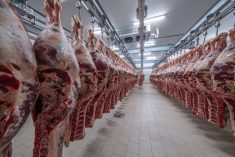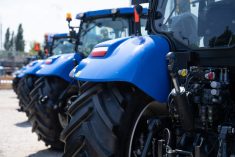A study of radio frequency identification (RFID) systems at cattle auction markets has found them best kept separate from other management software used at the auction sites.
The Canadian Cattle Identification Agency (CCIA) on Friday released results from the second phase of its research project, aimed at evaluating the impact of fully-integrated RFID at 13 different Canadian auction markets and buying stations.
Where the first phase looked at the ability of existing technology to collect and read RFID tag data at a high level of accuracy, the second phase looked at hardware configurations, and the use of commercial software to add the RFID hardware to a market’s business process.
Read Also

Ample supplies and improved livestock sector to boost Canadian feed sector: FCC
Abundant feed grain supplies and improved profitability for the livestock sector should support strong feed demand and sales through the winter, says a new report from Farm Credit Canada.
In Phase 2, "we explored the feasibility and potential benefits of linking the tag reading software with management software to support the availability of RFID numbers on sales and settlement documentation," project manager Donna Henuset said in a CCIA release.
Integrating those systems with RFID, however, "presented more challenges and expense than anticipated," she said.
The study found it would be "unnecessary" to integrate RFID software with markets’ business systems as a way of supporting movement reporting at co-mingling sites.
Furthermore, the study found the option of integrating RFID tag-recording software with those other livestock management systems to be "the most expensive" and to have "the greatest manpower requirements and impact on speed of commerce."
Also, the study found, "high annual operational costs" would outweigh the benefit of having RFID tag numbers listed on auction settlement documentation.
Most sites in the study reported not seeing any value for operations in terms of the buyer or seller having RFID tag numbers available on all invoicing and settlement sheets.
Some of the test sites also noted it could be tough to recruit and retain trained staff to use the integrated software. The effect on a market’s operations if those staff members were unavailable on scanning days could also be a problem, CCIA said.
As it stands, "the important aspect of (an integrated) system is a competent software operator who pays attention and doesn’t make mistakes," CCIA quoted an Ontario study participant as saying.
"If the (RFID tag-recording and reporting) software does not align with business process and operating objectives, it will not be efficient or effective," the study found.
"Minimal involvement"
With those findings in mind, CCIA is now instead evaluating "basic functionality software" that wouldn’t require integration with enterprise systems or data entry by group.
"This software may be a key factor in developing a system that can operate with minimal to no involvement from site personnel," Henuset said.
The "basic functionality" software was tested at six Canadian auction markets from September through November. Results of that evaluation should be determined sometime this month, CCIA said.
Rick Wright, chair of the CCIA project’s steering committee, hailed the project so far as having been "successful at identifying many challenges for movement reporting at the auction mart and buying stations."
Throughout the project so far, he noted, over 535,000 head of cattle have been scanned and reported to the Canadian Livestock Tracking System (CLTS).
















